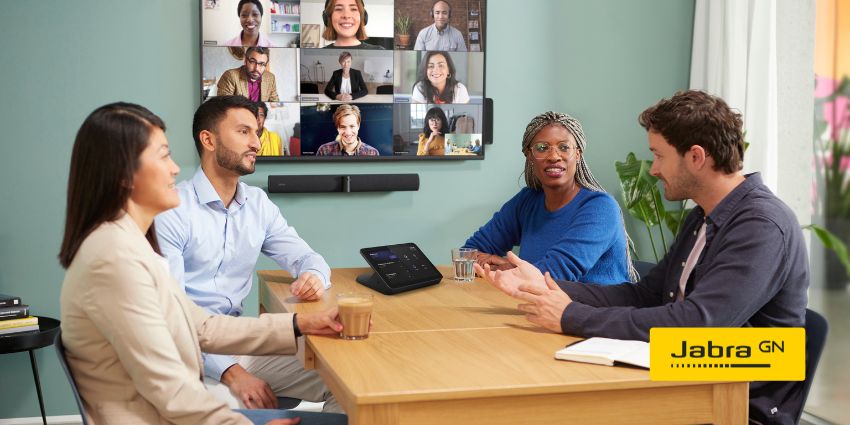The modern workplace has fundamentally transformed. The introduction of hybrid work has meant that employees are increasingly likely to have video calls to speak with their colleagues as they are to meet with them in person.
Although this ability to expand meeting participants to include those outside a physical meeting room has brought benefits, it has also ushered in challenges in ensuring seamless collaboration between in-office and remote participants.
Yet the root of this problem lies not in the concept of hybrid meetings, but in the technological limitations of legacy systems that weren’t designed for the nuanced demands of mixed-presence collaboration.
As James Spencer, Video Solutions Director for EMEA North at Jabra, explains: “We’ve all been on those calls where we can’t quite see that person at the back of the room or we can’t quite see them at home.”
This disconnect doesn’t just affect individual meeting experiences; it fundamentally undermines the collaborative potential of hybrid work itself.
But just as new technology enabled the shift to hybrid work in the first place, the next wave of innovation—AI-optimized meeting systems—promises to break down the barriers of persistent visibility and engagement challenges to create truly seamless hybrid collaboration.
Why Remote Participants Are Left Behind
The hybrid meeting format has created an inherent asymmetry that traditional video conferencing systems struggle to address.
Remote participants consistently report feeling disconnected from in-room discussions, missing crucial non-verbal communication cues, and struggling to maintain engagement throughout meetings.
This is because, unlike meeting in person where participants can keep track of speakers and the flow of dynamic group conversations happening in the meeting room, traditional meeting cameras often only give a fixed and static view that robs remote attendees of that nuance.
The problem becomes particularly acute in smaller meeting spaces, which now dominate office layouts. “94% of work is actually happening in small rooms today,” Spencer says.
Yet these spaces often lack the sophisticated camera systems to capture and transmit the full meeting experience properly.
As a result, remote participants frequently encounter scenarios where people too close to the camera are completely out of view, making it hard to keep track of contextual conversations between participants off-camera.
Equally, even companies who have invested in more advanced systems with motion and speaker tracking algorithms see the limitations, as they were designed for simpler, single-location meeting scenarios.
Spencer says these technologies create a “ping-ponging” approach, where cameras mechanically move between speakers without understanding conversational context or group dynamics.
Beyond the visual issues, audio often crops up as an additional hurdle for those remoting in.
Standard microphone arrays as part of video setups struggle with the acoustic complexity of meeting rooms, where voices from different positions require varying levels of amplification and noise cancellation to accurately pick up the right speaker.
This means remote participants often experience inconsistent volume levels, background noise interference, and difficulty distinguishing between speakers—problems that compound the visual tracking issues.
“When you don’t have this good video or audio, it can really become tiring to have to do all this extra mental work to stay focused and engaged,” Spencer explains.
This disconnect doesn’t just affect remote workers; it impacts overall meeting productivity and decision-making quality. When significant portions of meeting participants can’t fully engage with the discussion, organizations lose the diverse perspectives and collaborative dynamics that drive innovation and effective problem-solving.
AI-Powered Solutions: How the Next Generation Jabra Panacast 50 Room System Boosts Collaboration and Productivity
The Jabra PanaCast 50 Room System breaks the issues plaguing remote attendees in meetings by offering a system that anticipates and responds to meeting dynamics rather than simply reacting to them.
To do this, the system employs sophisticated AI algorithms that understand conversational patterns and group behaviors, enabling it to make intelligent decisions about camera positioning and audio capture.
The AI-powered speaker tracking system demonstrates this evolution in action. Rather than mechanically following individual speakers, the system analyzes conversational patterns to recognize when “there’s a back and forth going on” between participants.
In these scenarios, Spencer explains, the system makes the intelligent decision to “pan out so I can see both those people there” rather than continuously moving between them.
This contextual understanding eliminates the disorienting ping-pong effect while ensuring remote participants can see all active conversation participants simultaneously.
Through Jabra’s partnership with Lenovo, the system leverages the latest Intel chipsets within the compute units to provide the processing power necessary for this real-time AI analysis. This Windows-based computing platform delivers what Spencer describes as “speed of the processing” that ensures “no lag” when users interact with the system, creating a responsive experience that doesn’t impede meeting flow.
The system’s AI optimization also extends beyond camera control to audio intelligence and integration capabilities. Advanced microphone arrays work in concert with AI algorithms to automatically adjust audio levels, suppress background noise, and ensure optimal voice capture regardless of participant positioning within the room.
This intelligent audio processing goes beyond just remote viewers’ comprehension; it ensures that AI-powered transcription services like Microsoft Copilot can accurately identify individual speakers by voice recognition rather than generic room designations, significantly enhancing the value of post-meeting analytics and follow-up capabilities, further enhancing the meeting’s productivity.
More Flexibility and Choice for Hybrid Meetings
The evolution of workplace collaboration demands more than incremental improvements to existing video conferencing technology; it requires a fundamental shift toward intelligent systems that understand and respond to human meeting dynamics.
Yet with hybrid work and hot-desking now common, flexibility is just as important as intelligence when choosing the right collaboration technology.
That’s why Jabra’s PanaCast 50 Room System 2 offers multiple options for room setups with the flexibility to meet different needs. The compute device has USB-C integration, so users can easily share their screen, charge their laptop, or run a meeting in BYOD (Bring Your Own Device) mode. This enables access to the PanaCast 50 video bar from any platform.
Such flexibility also extends to deployment, with an IP version that allows a simple Ethernet connection instead of long USB runs. As Spencer explains, “Rather than having to run a USB cable from the bar to the tablet on the desk, we can just plug an Ethernet cable into the back.”
Because the system is also built to work with existing infrastructure, installation is simpler, giving IT teams more options for different room designs. This all makes the PanaCast 50 video bar “a long-term investment for years to come,” regardless of any workplace changes.
Taken together, this balance of choice, simplicity, and future-proofing means the PanaCast 50 Room System 2 does more than solve today’s hybrid challenges.
By combining AI-driven intelligence with genuine flexibility, the Jabra PanaCast 50 Room System 2 creates a platform for tomorrow’s collaboration.







